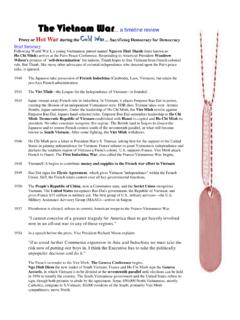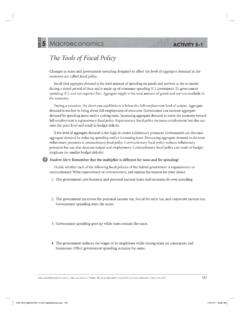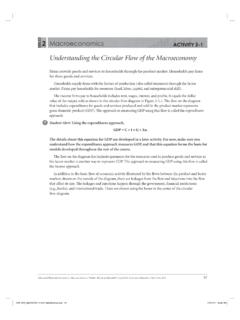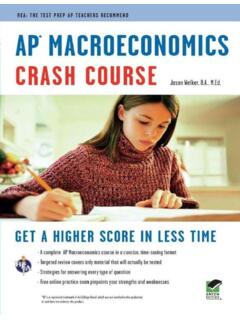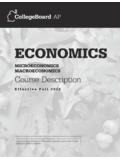Transcription of UNIT 5 Macroeconomics KEY IDEAS - allenisd.org
1 advanced placement Economics Macroeconomics : Student Activities National Council on economic Education, New York, Macroeconomic policy involves combina-tions of fiscal and monetary policies. The inside lag is the amount of time it takespolicy makers to recognize the economic sit-uation and take action. The outside orimpact lag is the amount of time it takes theeconomy to respond to the policy inside lag is long for fiscal policy andshort for monetary policy. The outside lag isvery short for fiscal policy and variable formonetary policy. Crowding-out is the effect on investmentand consumption spending of an increase ininterest rates caused by increased borrowingby the federal government.
2 The higher inter-est rates crowd out business and consumerborrowing. A Phillips curve illustrates the trade-offbetween inflation and unemployment. Thetrade-off differs in the short and long run,varies at different times and is often differ-ent for increases and decreases in output. The short-run Phillips curve shows a trade-off between the inflation rate and the unem-ployment rate. The long-run Phillips curve is vertical. Both monetary and fiscal policies are pri-marily aggregate demand policies, but notall of the macroeconomic problems in theeconomy are aggregate demand problems. If factors other than excess aggregate demandare contributing to inflation, it is difficult formonetary policy to control inflation.
3 The Barro-Ricardo effect is the possibilitythat government deficits will lead to anincrease in private savings and a decrease inconsumption, thus offsetting the effects ofexpansionary fiscal policy. economic growth is concerned with increas-ing an economy s total productive capacityat full employment or its natural rate of out-put. This output is represented by a verticallong-run aggregate supply curve. economic growth can be shown graphicallyas a rightward shift of a nation s long-runaggregate supply curve or a rightward shiftof its production possibilities curve. Short-run economic growth is usually meas-ured by changes in real gross domestic prod-uct or by changes in real GDP per capita.
4 The rate of economic growth is affected by avariety of aggregate supply and aggregatedemand factors. Different economic theories are only onereason why economists disagree. Other rea-sons are different assumptions, different val-ues, different interpretations about economichistory and different IDEAS about policy IDEASUNITA dvanced placement Economics Macroeconomics : Student Activities National Council on economic Education, New York, and Fiscal PolicyPart ATools of Monetary and Fiscal PolicyBoth monetary and fiscal policy can be used to influence the inflation rate and real output. Indicatewhat effect each specific policy has on inflation and real output in the short run (nine to 18 months).
5 Figure PolicyInflationReal Output1. (A) Buy government securities(B) Sell government securities2. (A) Decrease the discount rate(B) Increase the discount rate3. (A) Decrease reserve requirement(B) Increase reserve requirementFiscal PolicyInflationReal Output4. (A) Increase government spending (B) Decrease government spending 5. (A) Increase taxes (B) Decrease taxesPart BLags in Policy MakingAs the economic situation changes, policy makers must decide when to take action and which policyaction to take. Then they must implement the policy. The economy then responds to the policy. Theamount of time it takes policy makers to recognize and take action is called the inside lag.
6 Theamount of time it takes the economy to respond to the policy changes is called the outsideorimpactlag. The inside lag is estimated to be short for monetary policy but long for fiscal policy. The insidelag is long for fiscal policy because the legislative branch must come to agreement about the appro-priate action. The outside lag, however, is long and variable for monetary policy but very short forfiscal Explain why the inside lag can be short for monetary policy but the outside lag is long and 1 ACTIVITY 43 UNITA ctivity written by Rae Jean B. Goodman, Naval Academy, Annapolis, placement Economics Macroeconomics : Student Activities National Council on economic Education, New York, Explain why the outside lag is short for fiscal Explain why lags are important to the discussion of stabilization 1 ACTIVITY 43 (continued)UNITA dvanced placement Economics Macroeconomics : Student Activities National Council on economic Education, New York, : A Graphical RepresentationMonetary policy and fiscal policy do not exist in separate airtight compartments.
7 Monetary policyand fiscal policy can reinforce or accommodate each other, or they can work at cross-purposes. Thisactivity assumes no changes in the foreign exchange rate, imports or example, an expansionary fiscal policy will increase aggregate demand. The expansionary fiscalpolicy should also increase the demand for money. If the Fed does not increase the money supply,interest rates will rise. Because the government is borrowing money to finance its expansionary fiscalpolicy, consumers and businesses will be crowded-out of the financial markets. This could lower con-sumer and investment spending and slow down the economic expansion.
8 On the other hand, if theFed increases the money supply, interest rates should not rise as much. Of course, increasing themoney supply will increase the price level AUsing Aggregate Demand and Aggregate Supply Analysis1. Assume fiscal policy is expansionary and monetary policy keeps the stock of money constant atMS. Shift one curve in each graph to illustrate the effect of the fiscal policy.(A) Which curve did you shift in the short-run aggregate demand and aggregate supply graph?What happens as a result of this new curve?(B) In the money market graph, which curve did you shift to demonstrate the effect of the fiscalpolicy?
9 What happens as a result of this shift?MacroeconomicsLESSON 1 ACTIVITY 44 UNITA dapted from Phillip Saunders,Introduction to Macroeconomics : Student Workbook,18th ed. (Bloomington, Ind., 1998). Copyright1998 Phillip Saunders. All rights reserved. Activity revised by Rae Jean B. Goodman, Naval Academy, Annapolis, Using Aggregate Demand and Aggregate Supply AnalysisREAL GDPQUANTITY OFMONEYPRICE LEVELNOMINAL INTERESTRATESRASADMSMDi242 advanced placement Economics Macroeconomics : Student Activities National Council on economic Education, New York, (C) Given the change in interest rates, what happens in the short-run aggregate supply andaggregate demand graph?
10 (D) How could a monetary policy action prevent the changes in interest rates and output youidentified in (B) and (C)? Shift a curve in the money market graph, and explain how this shiftwould reduce BUsing the Loanable Funds MarketThe loanable funds market provides another approach to looking at the effects of increases in thebudget deficit. The demandfor funds in the loanable funds market comes from the private sector(business investment and consumer borrowing), the government sector (budget deficits) and the for-eign sector. The supplyof funds in the loanable funds market comes from private savings (businessesand households), the government sector (budget surpluses), the Federal Reserve (money supply) andthe foreign 1 ACTIVITY 44 (continued)UNITF igure Funds MarketQUANTITY OF LOANABLE FUNDSINTEREST RATESD private sectorAdvanced placement Economics Macroeconomics : Student Activities National Council on economic Education, New York, Shift one of the curves on Figure to indicate what occurs in the loanable funds market ifgovernment spending increases without any increases in tax revenue or the money supply.

